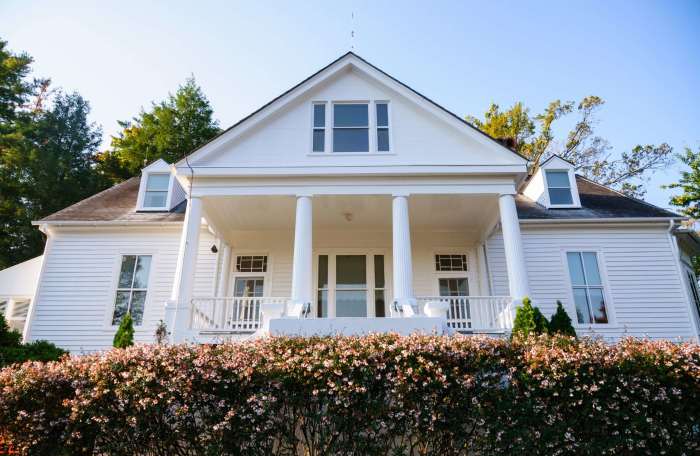Restoring the Past: Historic Home Restoration Specialists

Delving into the world of historic home restoration specialists unveils a fascinating realm where the past is meticulously preserved and brought back to life. From intricate details to grand structures, these specialists play a crucial role in maintaining the legacy of historical homes.
Let's explore the skills, challenges, and techniques that define this unique profession.
Overview of Historic Home Restoration Specialists

Historic home restoration specialists play a crucial role in preserving the architectural integrity and historical significance of older homes. These experts have the skills and expertise necessary to restore and maintain historic properties, ensuring that they are protected for future generations to enjoy.
Role of Historic Home Restoration Specialists
Historic home restoration specialists are responsible for carefully restoring and preserving the original features of historic homes. They work to maintain the authenticity and character of these properties while also implementing necessary repairs and upgrades to ensure their longevity.
Importance of Preserving Historic Homes
Preserving historic homes is essential for maintaining our cultural heritage and connection to the past. These properties serve as tangible links to history, offering valuable insights into the architectural styles, building techniques, and lifestyles of earlier time periods.
Skills and Expertise Required
- Knowledge of historical architecture and design principles
- Expertise in traditional building materials and techniques
- Attention to detail and precision in restoration work
- Ability to research and interpret historical documents and blueprints
- Collaboration with architects, historians, and preservation organizations
Key Responsibilities of Historic Home Restoration Specialists

Historic home restoration specialists play a crucial role in preserving the architectural integrity and historical significance of old properties. Their key responsibilities include:
Primary Tasks in Restoring Historic Homes
- Conducting thorough research on the history of the property to understand its original design and features.
- Identifying and documenting any damages or alterations that have occurred over time.
- Developing a restoration plan that adheres to preservation guidelines and regulations.
- Repairing and restoring original architectural elements such as windows, doors, moldings, and facades.
- Using traditional building techniques and materials to maintain authenticity.
- Collaborating with architects, historians, and craftsmen to ensure accuracy and quality in the restoration process.
Examples of Restoration Projects
Historic home restoration specialists often work on a variety of projects, including:
- Revitalizing Victorian-era homes with intricate woodwork and ornate details.
- Preserving colonial-era farmhouses with exposed timber frames and stone foundations.
- Restoring Art Deco buildings with geometric patterns and sleek finishes.
- Renovating mid-century modern homes with open floor plans and large windows.
Challenges Faced by Specialists
Restoring historic properties comes with its own set of challenges, such as:
- Dealing with structural issues caused by age, wear, and neglect.
- Finding skilled craftsmen and artisans who can replicate historic building techniques.
- Navigating through complex preservation guidelines and regulations.
- Sourcing authentic materials that match the original construction of the property.
- Balancing modern amenities with the preservation of historical integrity.
Techniques and Methods Used in Historic Home Restoration
Historic home restoration specialists utilize a variety of techniques and methods to preserve and restore the unique features of historical properties. These methods are essential in maintaining the integrity and authenticity of these homes, ensuring that they stand the test of time for future generations to appreciate.
Common Techniques Used by Specialists
Historic home restoration specialists often employ techniques such as:
- Preservation of original materials: Specialists carefully remove damaged or deteriorated materials while preserving as much of the original material as possible.
- Replication of historical elements: When original materials are beyond repair, specialists replicate historical elements using traditional methods and materials to maintain historical accuracy.
- Conservation cleaning: Gentle cleaning methods are used to remove dirt and grime without causing damage to delicate historical surfaces.
Traditional Materials and Tools Employed in Restoration Work
In historic home restoration, specialists rely on traditional materials such as:
- Wood: Traditional woods like oak, pine, and cedar are commonly used for repairs and replacements.
- Plaster: Lime-based plaster is often used to replicate historical finishes and textures.
- Hand tools: Hand tools like chisels, hand saws, and planes are essential for delicate restoration work.
Comparison of Modern Restoration Methods with Traditional Approaches
While modern restoration methods offer efficiency and convenience, traditional approaches are valued for their authenticity and historical accuracy. Modern techniques may involve the use of power tools and synthetic materials for faster results, but they can sometimes compromise the original character of historical homes.
On the other hand, traditional methods prioritize the preservation of historical integrity, using time-tested techniques and materials to ensure that the restoration remains true to the original craftsmanship.
Preservation Guidelines and Regulations
When it comes to restoring historic homes, specialists must adhere to strict regulations and guidelines to ensure the preservation of the property's historical integrity. It is crucial for professionals in this field to follow preservation standards to maintain the authenticity and value of these properties.
Regulations Impacting Restoration Process
Preservation guidelines and regulations play a significant role in shaping the restoration process of historic homes. Here are some examples of how regulations impact the restoration projects:
- Historical Accuracy: Preservation guidelines often dictate that specialists must use historically accurate materials and techniques when restoring a historic home. This ensures that the property retains its original charm and character.
- Structural Integrity: Regulations may require specialists to prioritize the structural integrity of the building, ensuring that any restoration work does not compromise the stability of the property.
- Permit Requirements: Restoring historic homes often requires obtaining permits from local authorities to ensure that the work meets preservation standards and complies with zoning regulations.
- Conservation of Original Features: Preservation guidelines may mandate the conservation of original features, such as windows, doors, and architectural details, to preserve the historical significance of the property.
Outcome Summary
As we conclude our exploration of historic home restoration specialists, we are reminded of the dedication and expertise required to breathe new life into old spaces. The blend of tradition and innovation showcased in their work stands as a testament to the timeless beauty of historical preservation.
FAQ Compilation
What qualifications are needed to become a historic home restoration specialist?
To become a specialist, one typically needs a background in architecture, historic preservation, or a related field. Specialized training and hands-on experience are also crucial.
How do specialists balance modern amenities with historical authenticity in restoration projects?
Specialists often carefully integrate modern conveniences into historic structures while preserving the original features to maintain the historical integrity of the property.
Do historic home restoration specialists work with local historical societies and preservation organizations?
Yes, specialists frequently collaborate with these groups to ensure that restoration projects adhere to preservation standards and guidelines set forth by the community.

